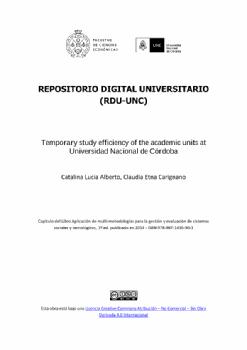| dc.description.abstract | The Universidad Nacional de Córdoba (UNC) founded in 1613 is the oldest and one of the largest in the country. In 2011 it had 121,476 undergraduate students, 9,156 teaching positions and 83 degree programs. The university has 13 academic units, two pre-college high schools, two teaching hospitals and a blood lab. As well as the best universities in the world, UNC could also be helped in achieving its goals through a careful planning, a commitment to excellence by teachers, administrative staff and students, and its determination to invest in areas which aim at quality improvement. Moreover, the external parameters which its programs and activities must be submitted to in order to achieve higher levels of accreditation, financial availability, international associations memberships or rankings presence, are constantly increasing. With regard to the distribution of the budget, the University lacks a management system able to link the different levels and actors which are relevant to a process of institutional planning. The University Annual Budget is fundamentally made on historical basis, with a clear focus on inputs (means) financing, leaving the expected results (goals) unattended. Thus, there is a "transparent" distribution on its relative loads, which original basis have already lost sustenance or are even unknown, but are still respected as a main guideline and a way to ensure consensus. Therefore, the budgetary debate usually focuses on annual increases. Those discussions are framed by institutional development objectives previously defined, e.g. growth of public work, care for the new needs demanded by the teachers, scholarships, science and technique. Nevertheless, criteria on which these priorities are set and the resources for each AU or project are finally allocated are not always clear. As a corollary it can be said that there is still much to do in terms of improving budgetary decision making. The purpose of this paper is to make a contribution in this direction by analyzing and comparing the performance of academic units between 2007 and 2011. A measurement of technical efficiency is proposed, using a nonparametric mathematical programming model (DEA) approach. This scope has been researched by many authors, such as Avkiran (2001), Stern Z., Mehrez A. and Barboy A. (1994), Tomkins C. and Green R. (1988) and Thanassoulis E. and Dunstan P. (1994), among others. | es |





